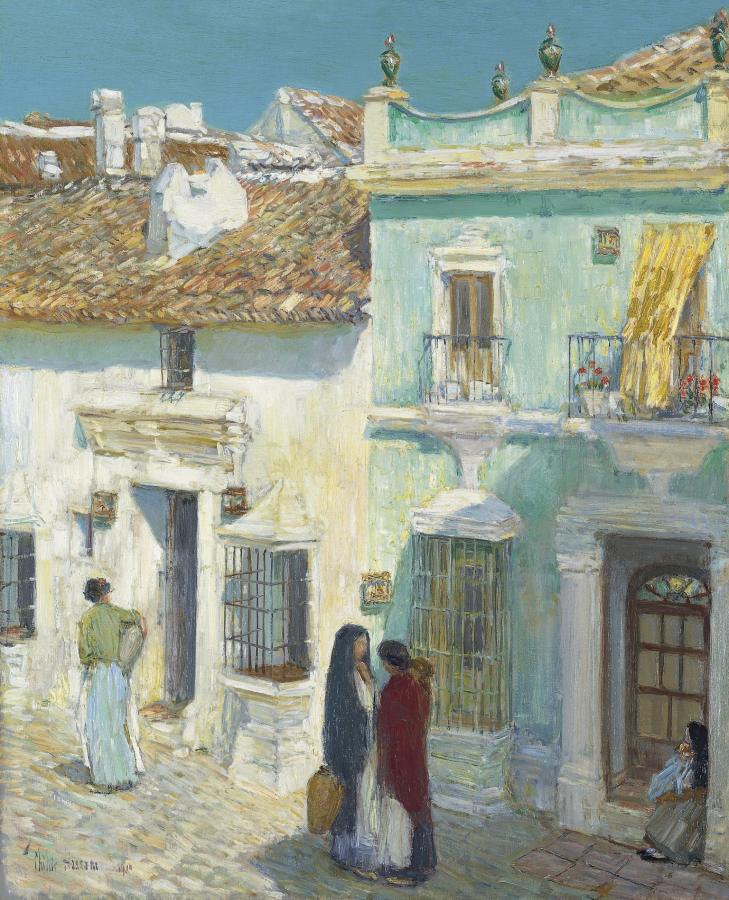Hassam, Childe (1859-1935)
Plaza de la Merced, Ronda
1910
Oil on panel, 64.6 x 52 cm
Museo Thyssen-Bornemisza, Madrid
©Carmen Thyssen Collection
After travelling through northern Europe in the summer of 1910, Childe Hassam and his wife journeyed to Spain, where the artist painted in Madrid, Toledo, Cordova, Seville and Ronda before returning to America from Gibraltar in late October or early November. Hassam later reflected that his trip was motivated in part “as I never painted in oil in Spain, I wanted to get some things in Spain“. Oils from Hassam‘s European trip along with pastels and watercolours were exhibited at the Montross Galleries in New York the year following his return. Although a partisan critic for the Newark Evening News declares every single painting a masterpiece in what he considered “the most important exhibition of pictures ever held in this country, ” other reviewers felt the show revealed the uneven quality of Hassam‘s work. The six oils of Spain that were shown, however, labelled by the press as the “Spanish set, ” received unanimous praise.
While one critic recognised in the Spanish series “the strong light and the depth of the blue in the sky [which] suggest the bold schemes of the younger painters in Paris, ” most felt that although the paintings were radiant with light, they displayed either a “reticence of color, ” or were “delicate and tender.” Hassam‘s Spanish paintings were found to be simple, direct “portraits of places.” The scenes were artistic, not operatic, revealing a delicate discrimination, rather than a gorgeous riot of brushwork. He avoided the romanticising of Spain prevalent in the paintings of Édouard Manet and the writings of Théophile Gautier.
The critics were also quick-perhaps too quick-to point out that Hassam‘s Spanish scenes revealed no influence from that country’s two most important contemporary painters, Fortuny and Sorolla. The New-York Daily Tribune noted that Hassam not only did not turn Spain‘s picturesqueness into romantic theatricality but that he avoided “the staccato effect, the sharp flicker of light and shade, which, one phase of Fortuny’s art beguiled a generation of merely clever men into using with foolish persistence.” “Mr. Hassam is much more than a clever painter, ” he wrote, “and his Spanish subjects have a serious value.” The New York Sun also disavowed any influence from the Spanish art: “That he would not return with Sorolla patterns one could easily guess. Despite his profound admiration for Señor Bastida (à la main gauche) Mr. Hassam is not that sort of an impressionist.” Nevertheless, the Newark Evening News proudly noted that when Sorolla attended the Monstross exhibition, he responded favourably with a “très bien” after viewing Hassam’s Spanish subjects.
Of the six paintings of the “Spanish set, ” two were of Ronda subjects, La Merced, Ronda (1910, New York, The Hispanic Society of America) and this painting Plaza de la Merced, Ronda. The Hassams were undoubtedly staying at the Hotel in Ronda, a moderately-priced Hotel in English hands opposite the church, La Merced, which was separated by a tree-lined plaza. The hotel was situated in the Mercadillo, or new quarter, of Ronda, which dated primarily from the 18th century and was characterised by its balconies and white-washed buildings. The view Hassam painted of the church and of the buildings to the right of the Plaza de la Merced could easily have been taken from his hotel windows. Throughout his life Hassam often favoured a vantage point looking down upon the scene, whether the locale was Boston, New York, Paris or Spain.
Hassam‘s paintings were purchased by Horatio Seymour Rubens, whom Hassam fondly remembered as a “great collector of American paintings.” Rubens, who was counsel for the Cuban junta which led to the Spanish-American war, owned paintings by Hassam, portraits by Stuart, Sargent, and the English painters, Raeburn, Lawrence and Gainsborough, as well as possessing a large collection of Oriental objects by the time of his death. By the time Rubens purchased the painting through Milch Galleries, New York, it was know as Street Scene, Ronda, Spain.
Kenneth W. Maddox (T-B)
